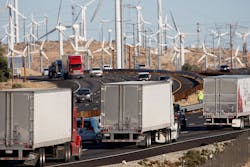Program puts fleets on path to sustainability
April 20, 2015
4 min read
Creating a cleaner environment – fleet by fleet. That’s the philosophy behind a sustainability accreditation program that the NAFA Fleet Management Association and CALSTART have come up with to help fleets become greener.After two years in the making, the two groups launched a four-tiered rating system that evaluates fleets based on their environmental performance. The purpose of the program is to help fleets measure, monitor and improve environmental sustainability by achieving three goals: reducing greenhouse gas emissions, burning less fuel, and building fleets with more fuel efficient vehicles.“This is a real-life program built by fleet managers for fleet managers,” NAFA CEO Phillip Russo said, adding that 40 fleet managers were involved in the program’s development. “This is a practical way of becoming a better, more sustainable fleet.”The impetus behind developing the program, according to Russo, was because there was no real definitive way to determine what it meant to be a sustainable fleet.“We felt that as the association for fleet managers that we were the right organization to say this is what it means to be sustainable,” he told Fleet Owner. “It’s important for our environment, and to get the results to help the environment and clean our air, you need to set a path for people. We are giving them the parameters for how they need to get there.”The program is set up as a tiered-level performance rating system in which fleets move through the ranks by earning points as they achieve sustainability goals. In order for fleets to participate, they must first provide a one-year report of their fuel plan and list of their vehicles. In addition, they must submit a sustainability plan that highlights their goals and how they hope to accomplish them.The program complements the DOE National Fleet Partnership program and other federal regulations by setting sustainability targets and recognizing fleets for achieving them. NAFA announced the launch of the program at its Institute & Expo conference in Orlando in mid-April.Once fleets submit their data, they will receive a report illustrating where they stand and what tier they fall into. The most basic level tier – in which fleets are known as committed sustainable fleets – comprises fleets that have submitted their fuel reports and sustainability plans. Fleets doing more, such as using alternative, sustainable tools and practicing driver efficiency, can earn points and move up through the tiers, CALSTART senior vice president Bill Van Amburg explained. When fleets make it to the fourth tier, Van Amburg said, it means they have made “world-class” progress in attaining their sustainability goals – so reducing greenhouse gas emissions by about 4% a year and significantly lowering their net fuel burn.“The program is designed for continual improvement,” Van Amburg told Fleet Owner. “It allows them to quantify where they are, and they can prove they are doing what they say they are doing. It becomes a really strong tool for fleet managers to make the case of where they want to get in cost savings and in helping the environment.”Van Amburg said fleets can also use their accreditation as a tool to set them apart from other fleets in the marketplace. And no matter where fleets end up ranking, the overall goal of the program is to reduce emissions every year.“We want fleets to think about what they can do to help save money and do right by the environment,” Van Amburg said. “Then we can help you measure how to do that. I think a lot of fleet managers don’t realize that they have already started doing this. If you’re a fleet working in this arena, please consider joining because chances are you’re already moving down this path, and you may not even know it.”Though the program is voluntary, there is a cost to join. Fleets can join the program and learn more by visiting NAFASustainable.org. Fleets of all sizes and types – ranging from passenger cars to Class 8 heavy-duty tractor-trailers – can apply. Currently, 16 fleets are participating.“This is the practical way of becoming a better, more sustainable fleet,” Russo said. “We’re not backing any one particular technology or fuel or anything. We’re not doing this to make a profit, we’re doing this because it’s the right thing to do, and we think this is the best program out there.”
About the Author

Cristina Commendatore
Cristina Commendatore is a past FleetOwner editor-in-chief. She wrote for the publication from 2015 to 2023.
Sign up for our eNewsletters
Get the latest news and updates
